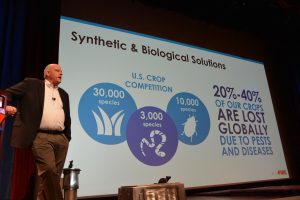 Bayer is wrapping up the registration process for California registration of Velum One, a nematicide with fungicidal activity. The product is anticipated for use on almonds, tomatoes, strawberries, brassicas and cucurbits by the 2017 growing season. It will help growers manage a wide spectrum of nematodes.
Bayer is wrapping up the registration process for California registration of Velum One, a nematicide with fungicidal activity. The product is anticipated for use on almonds, tomatoes, strawberries, brassicas and cucurbits by the 2017 growing season. It will help growers manage a wide spectrum of nematodes.
“During trials, early season application has been shown to protect root heath and get plants off to a great start,” said Joel Lipsitch, product manager for Bayer. “With Velum One, we will not only protect crops early in the season, but more importantly, we will give growers confidence that they’re using the right tools for the best return on their investment.”
Velum One contains a unique blend of active ingredients that work together to combat nematodes and damaging diseases. It moves from roots to leaves, not only suppressing nematodes below ground but also throughout the plant to suppress key diseases and help maximize yield potential.
“Field trials have shown that Velum One significantly increases yields and has an even greater impact when used with the insecticide/nematicide Movento and full disease management products like Luna,” added Lipsitch.
 The product is applied through drip/micro chemigation and offers significant enhancement to existing nematode programs. Velum One can immobilize nematodes within one to two hours after contact and is effective on early season diseases like powdery mildew.
The product is applied through drip/micro chemigation and offers significant enhancement to existing nematode programs. Velum One can immobilize nematodes within one to two hours after contact and is effective on early season diseases like powdery mildew.
“Once registered, Velum One will bring excellent protection to California crops in the coming year,” said Lipsitch. “We’re thrilled to bring growers a great option for nematode management to help maximize yield.”
Velum One is not currently registered for sale or use in California.











